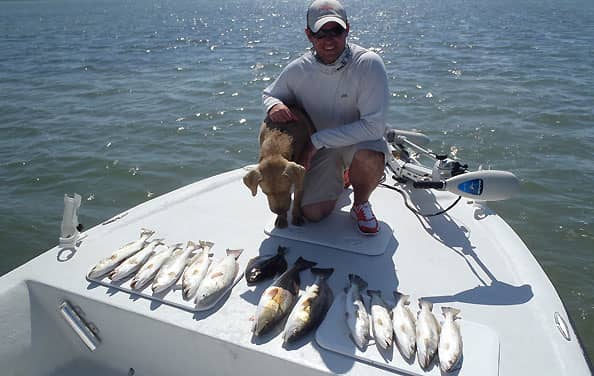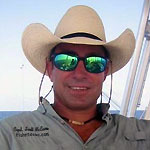Guide to Saltwater Live Bait Part 1: The Five Types
Fishhound 09.24.12

Written by Fishhound pro Captain Scott McCune, the “Saltwater Cowboy”.
I see weekend fisherman who spend a lot of time on the water, and I’m amazed that they don’t really adapt to the methods professionals use to consistently catch fish.
Be warned: If you’re a lure aficionado or tournament angler, then this article isn’t for you. Sorry.
The truth is, I see a lot of authors write about how fast to work your chartreuse, pumpkinseed, gold-flakey, curly-tailed fish-whackers or how to find sandy, shelly, grassy flats and drop offs. So I thought I’d write about something most of you could really use to catch fish more consistently, and that’s live bait.
The first way to fish live bait, although many guides have given up on this method because it requires more effort to train the customers, is the shrimp and popping cork (SPC). The second is anchoring up and fishing the sand pockets located in the flats. The third is anchoring up and fishing guts and isolated deep-water areas locked within the flats systems during low tide. The fourth and fifth are fishing with piggies (piggy perch, not pin perch) and croaker.
Those are the whats, but now let me explain when we use them, because this is the most important part. Wind is the critical indicator of what method we’ll use. I personally pray for wind so we can use the most popular, successful and frequently engaged method – shrimp and popping cork. SPC can be used for the longest timeframe during the year.
Shrimp and popping cork
The SPC method allows my customers more of a chance to do the fishing themselves. A good rule of thumb is, when the wind’s blowing 15 knots or more, this is the best option to catch fish. However, it’s only an option in the fall, winter and spring because the baitfish mature. In the summer, this method becomes unfeasible. Also, the larger fish don’t seem to gobble up the shrimp as readily. So if you use the SPC method in the summer, the fish might seem to range in the 14″ and under category, which will leave you hungry at the end of the day.
Sand pockets
If there’s no wind, put the shrimp and popping cork aside. Seriously. You’ve got to get used to fishing the sand pockets (potholes) and put your time in doing it. This is a very important tip: If there’s no wind, don’t try to revert back to drift-fishing the SPC. It’ll take time to gain confidence fishing the sand pockets, but it’s worth the effort because nothing’s more effective on light-wind or windless days.
Sand-pocket fishing can be done with live mullet, cut mullet, dead shrimp, live shrimp, pin perch, piggy perch, ballyhoo or crabs. I mainly like to use live bait when there’s little wind. However, I’ll almost always mix it up with cutbait too, just to add scent to the water. You can use everything from a jighead to a Carolina-rig with various weights. We also add a water-cork at times to get extra casting distance, which is very important on the days without wind.
Low tide
The next style of fishing is low-tide fishing. Hopefully you’ve studied your map or taken notes when crossing he flats on normal-tide days. If so, you’ll have areas in the back of your mind to try when the low-tide conditions present themselves.
Be very careful if you don’t know the area well – maybe watch another boat enter that area and wait your turn to try it. Remember: Some lanes into the deeper guts in the flats system aren’t even as wide as your boat. We use the anchor-up method of fishing on these days too.
Because a low-tide day can be either windy or calm, my choice of primary bait is based on this rule: Use any type of bait that’ll create a scent on windy days. On calm days, use live bait. The simple reason is that on windy days the water’s murky and hard to see through, thus the fish need to follow the scent to find the bait. On calm days, the fish can actually see what they inhale from quite a distance away.
 Piggies and croaker
Piggies and croaker
The forth and fifth methods – piggies and croaker – are very similar, so I’ll combine them. The reason I classify them as two different styles is because of the areas in which we use them.
Croaker (pictured) seem to stay effective way longer in the area north and south of Port Aransas, such as the Laguna to the south and San Antonio Bay to the north. In the Rockport and Port Aransas areas, Croaker mature faster than piggies to be used as bait, but when piggies start coming in, look out.
Piggies and croaker are revered by fishing guides because when you’re on fish and the time is right, you can’t find a hotter trout bait. And redfish will tear ’em up too.
We fish these two types of bait at the rigs, at the grass edges off the deeper bay islands, the reefs, the Intracoastal Waterway and the sand pockets in the flats.
The preferred rig is a size-appropriate kahle hook tied to a 20-pound leader attached with a swivel or knot to the main line. The time of year we use this bait is from about the middle of May into September. At that time the bait’s predominantly too large and the schools start migrating.
Now that you know why and when we fish certain baits, we can start talking about the various techniques that make a difference in presenting them to our prey. That comes with the next article. After all, I do have to make some time to fish instead of just write.
 All kidding aside, I want to spend time covering each of these methods more in depth, as they all have their place in our fishing arsenal. I hope you’ve enjoyed this article and remember: If you don’t eat it, release it. And try to release all big trout. Get a picture: It’ll last longer and will save some for the kids.
All kidding aside, I want to spend time covering each of these methods more in depth, as they all have their place in our fishing arsenal. I hope you’ve enjoyed this article and remember: If you don’t eat it, release it. And try to release all big trout. Get a picture: It’ll last longer and will save some for the kids.
Capt. Scott McCune, the “Saltwater Cowboy,” is a nearshore and offshore guide and tournament competitor in Port Aransas, Texas. His two sites,TheSaltwaterCowboy.com and FishnTexas.com, chronicle the Texas Gulf Coast experience. Connect with him there, or send him an email atScott@FishnTexas.com.


